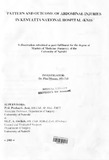| dc.description.abstract | Eighty consecutive admissions of patients with abdominal injuries were recruited into this
prospective study conducted over a period of three and half months between November 2004 and
mid-February 2005. It involved patients in the adult general surgical wards only. There were 74
males and 6 females giving a male to female ratio of 12.3: I. The age ranged from 15 years to 56
years with a mean of 28.2 years. Majority of the patients (53.8%) were in the third decade of life.
Fifty-three patients had penetrating while 27 had blunt abdominal injuries. The common causes of
penetrating abdominal injuries were stab wounds (64.2%), gunshot wounds (32.1 %) and arrow
wound (3.7%). Road Traffic Accidents (44.4%), assault (37.0%) and faJJ from heights (14.8%)
were the leading causes of blunt abdominal injury. Overall, stab wounds, gunshot wounds (GSWs)
and Road Traffic Accidents (RTAs) are the three top causes of abdominal injuries.
Fifty-two patients (65%) had isolated abdominal injuries while the remaining 28 had associated
extra-abdominal injuries. Seven of these had more than one extra-abdominal injury. Blunt
abdominal injuries had a higher tendency to have associated extra-abdominal injuries. The injured
extra-abdominal parts included the chest, limbs, head and pelvis.
The duration prior to presentation to hospital depended on the degree of injury. Severe injuries
presented early and vice-versa. The shortest duration was one hour and the longest one week. Sixty
patients (75%) presented within the first six hours of injury. The type of injury did not determine
the duration prior to presentation to hospital.
As of the time of admission, 80% of the patients had normal vital signs. Out of 16 patients admitted
with abnormal vital signs, I I had penetrating abdominal injury. Eighty percent of the blunt
abdominal injuries with abnormal vital signs died. Less than 40% (36.4%) of the penetrating
abdominal injuries with abnormal vital signs died, showing a better interventional outcome in the
penetrating than blunt abdominal injuries.
Patients were managed according to decisions made by the attending firms (wards SA, SB and SD).
Fifty-six patients (70%) were operated on while 24 were subjected to conservative management.
The modes of management and success of interventions varied from firm to firm.
Of the operated, 6 had initially been on conservative management (five blunt and one penetrating),
showing a 20% change in the mode of management. Nine patients of the 56 operated on had
negative laparotomies, giving a 16. I% rate of negative laparotomies. Eighty percent of the initially
conserved patients with blunt injuries had positive findings on laparotomy.
The waiting period before surgery for those primarily operated on ranged from half an hour to
twenty hours and was depended on the degree of injury and state of patient rather than type of
injury. For the initially conserved patients, blunt abdominal injuries took almost three times the
penetrating injury waiting time before surgery could be performed. This would suggest greater
dilemma in the management of the stable patients with blunt abdominal injury as to when to change
instituted mode of treatment. There was correlation between duration prior to surgery and
complications as well as deaths.
Ten patients developed complications, grvmg a 12.5% rate of complications. The complications
included sepsis, rebleed, enterocutaneous fistula and gas gangrene of anterior abdominal wall.
Ninety percent of the patients who had complications had undergone surgery.
Eight patients (10%) were admitted to the Intensive Care Unit (ICU). Surgery had been performed
in all of them. While there was no difference between type of injury and need for ICU admission,
the mortality rate was higher in blunt than in penetrating abdominal injuries (75% vs 50%). The
overall mortality for patients with abdominal injury admitted to ICU was 62.5%.
Twenty-three patients (fifteen penetrating and eight blunt) had blood transfusion. Twenty-one of
these patients had laparotomy performed, yielding 19 positive and 2 negative laparotomies.
Operative interventions was a strong reason for blood transfusion even in those with negative
laparotomies. The 2 negative laparotomy patients who were transfused had a pre-existing anaemia
that required transfusion after surgery.
Ten patients (six blunt and four penetrating) succumbed to their injuries, making the mortality rate
in abdominal injuries to be 12.5%. The correlates for mortality were long periods of conservative
management in patients not showing improvement, associated extra-abdominal injuries, duration
prior to admission, duration prior to surgery, admission to ICU and need for blood transfusion.
Majority of the patients (32) stayed up to five days. Within ten days, 88.6% of the patients had been
discharged. The duration of stay depended on whether or not there were associated extra-abdominal
injuries and presence or absence of complications. On the whole, the average duration of stay for
abdominal injuries was 6.4 days with no significant difference between the type of injury and
duration of stay for the simple, isolated injuries. For the abdominal mjunes with resultant complications, blunt injuries stayed almost twice as long as the penetrating injuries. | en |
| dc.description.department | a
Department of Psychiatry, University of Nairobi, ; bDepartment of Mental Health, School of Medicine,
Moi University, Eldoret, Kenya | |

